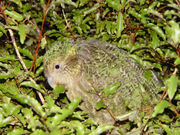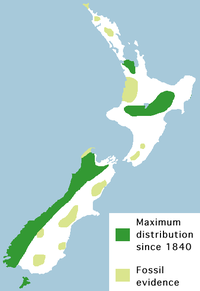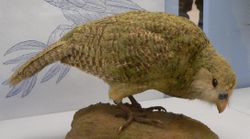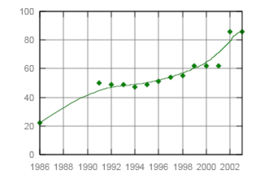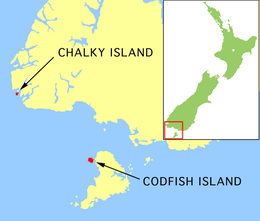Kakapo
2007 Schools Wikipedia Selection. Related subjects: Birds
| iKakapo | ||||||||||||||||||
|---|---|---|---|---|---|---|---|---|---|---|---|---|---|---|---|---|---|---|
 |
||||||||||||||||||
|
|
||||||||||||||||||
| Scientific classification | ||||||||||||||||||
|
||||||||||||||||||
|
|
||||||||||||||||||
| Strigops habroptilus Gray, 1845 |
The Kakapo ( Māori: kākāpō, meaning night parrot), Strigops habroptilus (from the Greek strix, genitive strigos: owl and ops: face; and habros: soft, and ptilon: feather), is a species of nocturnal parrot endemic to New Zealand. It is notable for being the world's only flightless parrot, the heaviest parrot, and the only parrot to have a lek breeding system. It is also the only flightless lek bird and is possibly one of the world's longest-living birds. It is the only species in the genus Strigops and the tribe Strigopini, which is placed in the subfamily Psittacinae, or alternatively the kakapo forms a subfamily of its own, Strigopinae.
Kakapo are critically endangered, with only 86 living individuals known, all of whom are named. Prehistorically, the ancestral Kakapo migrated to the islands of New Zealand and, in the absence of mammalian predators, it lost the ability to fly. With Polynesian and European colonisation and the introduction of predators such as cats, rats, and stoats, almost all the Kakapo were wiped out. Conservation efforts began in the 1890s, but they were not very successful until the implementation of the Kakapo Recovery Plan in the 1980s. All surviving Kakapo are kept on two predator-free islands, Chalky Island in southwest Fiordland and Codfish Island/Whenuahou near Stewart Island/Rakiura, where they are closely monitored.
Physical description
Kakapo are large, rotund parrots: males measure up to 60 centimetres (24 in) and weigh between 3 and 4 kilograms (7–9 lb) at maturity. Kakapo are unable to fly, having short wings for their size and lacking the pronounced keel bone ( sternum) that anchors the flight muscles of other birds. They use their wings for balance, support, and to brake their falls when leaping from trees. Unlike other land birds, Kakapo can accumulate large amounts of body fat to store energy.
Kakapo have moss-green feathers barred with black on the back, blending well with native vegetation. As the feathers do not need the strength and stiffness required for flight, they are exceptionally soft, giving rise to the specific epithet habroptilus. Their underbellies, necks, and faces are yellowish with great variability between individuals. It is known from museum specimens that some birds had completely yellow colouring. Kakapo have a facial disc of fine feathers, resembling the face of an owl; thus early European settlers called it the owl parrot. Their beaks are surrounded by delicate "whiskers", which they use to sense the ground as they walk with their heads lowered. The ends of their tail feathers often become worn from being continually dragged on the ground.
The beak of the Kakapo is specially adapted for grinding food very finely. For this reason, Kakapo have very small gizzards compared to other birds of their size. Kakapo feet are large, scaly and, as in all parrots, zygodactyl (two toes face forward and two backward). They have pronounced claws that are particularly useful for climbing.
Kakapo have a well-developed sense of smell which complements their nocturnal lifestyle (Hagelin 2004). Kakapo can also discriminate among odours while foraging; this behaviour has only been reported for one other parrot species. One of the most striking characteristics of Kakapo is their pleasant and powerful odour, which has been variously described as like flowers and honey, an air freshener, or the inside of an antique violin case. Given the Kakapo's well-developed sense of smell this scent may be a social chemosignal. The smell has often led predators right to the relatively defenseless Kakapo.
Reproduction
Kakapo are the only parrots in the world that have a lek breeding system. Males loosely gather in an arena and compete with each other to attract females to mate. Females watch the males display or "lek". They choose a mate based on the quality of his display; they are not pursued by the males in any overt way. No pair bond is formed and males and females meet only to mate.
During the courting season, males leave their usual territories for hilltops and ridges where they each establish their own mating courts. These leks can be up to 7 kilometres (4 mi) from a Kakapo's usual territory and are an average of 50 metres (160 ft) apart within the lek arena. Males remain in the region of their court throughout the courting season. At the start of the breeding season, males will fight to try to secure the best courts. They confront each other with raised feathers, spread wings, open beaks, raised claws and loud screeching and growling. Fighting may leave birds with injuries.
Each court consists of a series of bowl-like depressions dug in the ground by the male, up to 10 centimetres (4 in) deep and long enough to fit the half-meter length of the bird. Bowls are often created next to rock faces, banks, or tree trunks to help reflect sound. Each male’s bowls are connected by a network of trails or tracks which may extend 50 metres (160 ft) along a ridge or 20 metres (60 ft) in diameter around a hilltop. Males meticulously clear their bowls and tracks of debris. One way researchers check whether bowls are visited at night is to place a few twigs in the bowl, knowing that if the male visits overnight he will pick them up in his beak and toss them away.
To attract females, males make loud, low-frequency booming calls from their bowls by inflating a thoracic sac. They start with low grunts increasing in volume as the sac inflates. After a sequence of about 20 loud booms, the volume drops off. The male Kakapo then stands up for a short while before again lowering his head, inflating his chest and starting another sequence of booms. The booms can be heard for at least one kilometre (0.6 mi) on a still night and wind can carry the sound at least five kilometres (3 mi). Males boom for an average of eight hours a night; each male may produce thousands of booms in this time. This may continue every night for three or four months during which time the male may lose half his body weight. Each male moves around the bowls in his court so that the booms are sent out in different directions.
Females are attracted by the booms of the competing males; they too may need to walk several kilometers from their territories to the arena. There a female enters the court of one of the males. The male then performs a display in which he will rock from side to side and make clicking noises with his beak. He will turn his back to the female, spread his wings in display and walk backwards towards her. When in the presence of a female, males apparently become sexually excited, and may attempt to copulate with objects other than female Kakapo. Little is known about copulation but it is believed to be brief. Once the birds have mated, the female returns to her home territory to lay eggs and raise the chicks. The male continues booming in the hope of attracting another female.
Female Kakapo lay between one and four eggs per breeding cycle. They nest on the ground under the cover of plants or in cavities such as hollow tree trunks. They incubate the eggs faithfully, but are forced to leave them every night in search of food. Predators are known to eat the eggs. They may also freeze to death in the mother's absence. Kakapo eggs usually hatch within 30 days, bearing fluffy gray chicks that are quite helpless. The young chicks are just as vulnerable to predators as the eggs, and young have been killed by many of the same predators that attack adults. Chicks fledge and leave the nest at about 10 to 12 weeks of age. As they gain greater independence, their mothers may feed the chicks sporadically for up to 6 months.
Since Kakapo are quite long-lived, they tend to enjoy an adolescence before beginning breeding. Males do not start to boom until about 5 years of age. Females do not seek out males until they are between 9 and 11 years old. Although this is quite a long delay before they start to reproduce, Kakapo are thought to live at least 60 years, leaving plenty of time to perpetuate the species. Kakapo do not breed every year and have one of the lowest rates of reproduction among birds. Breeding occurs only in years when trees mast (fruit heavily), providing a plentiful food supply. Rimu mast occurs only every three to five years, so in rimu-dominant forest such as on Codfish Island, Kakapo breeding occurs as infrequently.
Ecology and behaviour
The ancestors of the Kakapo migrated to the islands of New Zealand millions of years ago. It is hypothesised that when they arrived, they were smaller and more like other parrots. Over time, they became larger, heavier, and lost the ability to fly. Interestingly, the only mammals native to New Zealand are three species of small bats (one now extinct), and it seems that birds have adapted to fill the niches that mammals occupy in other parts of the world. Before the arrival of humans, Kakapo were wildly successful; it is thought that there were millions alive at any one time.
Kakapo once ranged throughout the three main islands of New Zealand. They lived in a wide variety of habitats including tussocklands, scrublands and coastal areas. They also inhabited a variety of forests including those dominated by podocarps ( rimu, matai, kahikatea, totara), beeches, tawa, and rata. They particularly favored forest margins and areas of regenerating forest for the wider variety of vegetation in a compact area. In Fiordland, areas of avalanche and slip debris with regenerating and heavily fruiting vegetation such as five finger, wineberry, bush lawyer, tutu, hebes, and coprosmas became known as "Kakapo gardens".
Kakapo are primarily nocturnal, roosting under cover in trees or on the ground during the day and roving their territories at night. Though the Kakapo cannot fly, they are excellent climbers, ascending to the crowns of the tallest trees. They have also been known to "parachute" from heights by spreading their wings, floating gently to the forest floor. Having lost the ability to fly, Kakapo have developed very strong legs. In the course of a night's feeding they may walk several kilometres and climb 300 metres (1000 ft) up hills and down again. Kakapo are able to run at a fair speed, but cannot sustain their speed for long distances.
Kakapo are generally herbivorous, eating a wide variety of native plants, seeds, fruits, pollens and even the sapwood of trees. They are particularly fond of the fruit of the rimu tree, and will feed on it exclusively during seasons when it is abundant. Kakapo have a distinctive habit of grabbing a leaf or frond with a foot and stripping the nutritious parts of the plant out with their beaks, leaving a ball of indigestible fibre, similar to the way humans eat only the tender parts of artichokes. The little clumps of plant fibers are a distinctive sign of the presence of Kakapo. Kakapo have also been observed to occasionally eat insects and other invertebrates.
Kakapo are naturally curious, and though they live solitary lives in remote places, they have been known to enjoy the occasional company of humans. Conservation staff and volunteers have interacted extensively with some birds, and they are known to have distinct, and often charming, personalities.
Like many parrots, Kakapo have a wide range of calls used for various purposes. In addition to the "booms" and "chings" of their mating calls, they are often known to "skraark" to announce their location to other birds.
One behaviour that has not recently served the Kakapo well is their reaction to a predator or threat. When Kakapo feel threatened, they simply freeze, hoping to blend in with the vegetation that they so resemble. This was a good strategy to foil their main native predator, the giant Haast's Eagle. However, it does not protect them from their new mammalian predators, which rely on an excellent sense of smell.
Conservation
The population of Kakapo in New Zealand has been significantly reduced since human habitation of the country. Since 1891 conservation efforts have been attempted to prevent extinction. The most successful scheme has been the Kakapo Recovery Plan which was implemented in 1989.
Human impact
The first factor in the decline of the Kakapo was the arrival of humans about a thousand years ago. Māori settlers from Polynesia hunted the Kakapo for food and for their skins and feathers, which were made into luxurious capes. They also used the dried heads as ear ornaments. With its flightlessness, strong scent and habit of freezing in the face of danger, the Kakapo was easy prey for Māori and the dogs they brought to the islands. Their eggs and chicks were also predated by the Polynesian Rat or kiore which Māori also brought to New Zealand. Furthermore, the deliberate clearing of vegetation by Māori reduced the habitable range for Kakapo. Kakapo were extinct in many parts of the islands by the time Europeans arrived.
From the 1840s, European settlers cleared huge amounts of land for farming and grazing, further jeopardising the Kakapo and their habitat. They also brought more mammalian predators including cats, bigger species of rats and more dogs, all of which killed either adult or young Kakapo. Europeans knew little of the Kakapo until George Gray of the British Museum described it from a skin in 1845. Like Māori, early European explorers and their dogs fed on Kakapo. In the late 1800s, Kakapo became well known as a scientific curiosity, and thousands were captured or killed for zoos, museums and collectors. Most captured specimens died within months. From at least the 1870s, collectors knew that Kakapo were declining and possibly on the way to extinction. Unfortunately, their prime concern was to collect as many as possible before they were all gone.
In the 1880s, mustelids (stoats, ferrets and weasels) were released in large numbers in New Zealand in an attempt to reduce rabbit numbers (Murphy & Dowding 1995). They also preyed heavily on many native species including the Kakapo. Other browsing animals, such as introduced deer, also compete with Kakapo for food, and have caused the extinction of some preferred plant species.
Early protection efforts
In 1891, the New Zealand government set aside Resolution Island in Fiordland as a nature reserve and in 1894 appointed Richard Henry as caretaker. A keen naturalist, Henry was aware that native birds were declining because of introduced predators, particularly rats and stoats. Seeing the value of a predator-free island such as Resolution Island, he began catching and moving Kakapo and kiwi from the mainland to Resolution. In six years, he moved over 200 Kakapo to Resolution Island. Sadly, by 1900 stoats had swum to Resolution Island, colonised it, and killed all the Kakapo there within 6 years.
In 1903, three Kakapo were moved from Resolution Island to the nature reserve of Hauturu/Little Barrier Island north-east of Auckland, but feral cats were present on the island and the Kakapo were never seen again. In 1912, three Kakapo were moved to another reserve, Kapiti Island north-west of Wellington. One of them survived until at least 1936, despite the presence of feral cats for part of that period.
Unfortunately, world events superseded conservation efforts during the World Wars and the Great Depression. While most people's attention was understandably elsewhere, the Kakapo population continued to decline. By the 1920s, Kakapo were extinct on the North Island and their range and numbers on the South Island greatly reduced. One of their last refuges was rugged Fiordland. There, during the 1930s, they were often seen or heard, and occasionally eaten, by hunters or roadworkers. By the 1940s, reports of Kakapo were becoming scarce.
New Zealand Wildlife Service
In the 1950s, the New Zealand Wildlife Service was established and began making regular expeditions to search for Kakapo, mostly in Fiordland and what is now the Kahurangi National Park in the northwest of the South Island. Seven Fiordland expeditions between 1951 and 1956 found only a few recent signs. Finally, in 1958 a Kakapo was caught and released in the Milford Sound catchment area in Fiordland. Because of fears that introduced deer and chamois would colonise the area and eat out important food sources, as had happened elsewhere, the decision was made to take birds into captivity. In 1961 six Kakapo were captured, one being released and the other five transferred to the aviaries of the Mount Bruce Native Bird Reserve near Masterton in the North Island. Within months, four of the birds had died and the fifth died after about four years. In the next 12 years regular expeditions found few signs of Kakapo, indicating that numbers were continuing to decline. Only one bird was sighted during these years. It was captured in 1967 and, despite optimism about improved techniques for keeping Kakapo in captivity, died the following year.
By the early 1970s, it was uncertain whether Kakapo had survived. The availability of helicopters, however, enabled expeditions to reach previously inaccessible places. In early 1974, two Kakapo were captured in the Milford Sound catchment and moved to Maud Island in the Marlborough Sounds at the north of the South Island. As they were different sizes, it was hoped that one was female and the other male. After the suspected female was killed by a dog in 1977, the post mortem revealed it was a male.
At the end of 1974, searchers located several more male birds and made the first scientific observations of Kakapo booming. The observations led Don Merton to speculate for the first time that Kakapo had a lek breeding system. One bird was captured in the Milford area in 1975, christened "Richard Henry," and transferred to Maud Island. He is still living as of 2005 and judged to be over 50 years old. In 1976, four male Kakapo were discovered in the Transit Valley, the next catchment south of Milford Sound.
From 1974 to 1976, 14 Kakapo were discovered but all appeared to be males. This raised the possibility that all the females had died, perhaps killed by stoats while nesting, and that the species was functionally extinct. All the birds the Wildlife Service discovered from 1951 to 1976 were in U-shaped glaciated valleys flanked by almost-vertical cliffs and surrounded by high mountains. Such extreme terrain had slowed colonisation by browsing mammals such as deer and possums, leaving virtual islands of unmodified native vegetation. However, even here, stoats were present and by 1976 Kakapo were gone from the valley floors and only a few males survived high on the most inaccessible parts of the cliffs.
Although Kakapo expeditions had been mounted in the South Island, and occasionally in the North Island, since 1951, no expedition went to Stewart Island/Rakiura until 1977. This was despite government workers seeing a Kakapo there and snatching feathers from it in 1949. In 1970, a deerhunter photographed a Kakapo there and reported it to a Forest Service officer who apparently ignored the report. The 1977 expedition found a track and bowl system on its first day and soon located several dozen Kakapo, raising hope that the population would include females. In 1980, muzzled tracker dogs were brought in and a number of birds, including five females, were captured. The total population was estimated at 100 to 200 birds.
It was realised at the same time that although Stewart Island/Rakiura was free of stoats and other mustelids, feral cats were killing Kakapo at an alarming rate. Over 1980 and 1981, three females and a male were moved to Maud Island to join Richard Henry, the only Fiordland bird still alive. Between 1977 and 1982, cats killed 50% of the Kakapo that had been identified on Stewart Island/Rakiura. Thus, in 1982, eleven males and seven females were relocated to Hauturu/Little Barrier Island, from which feral cats had been eradicated in 1980. They were joined there by Richard Henry and the three surviving Stewart Island birds from Maud Island. Their removal from Maud Island was sparked by the discovery that a pregnant stoat had swum the 900 m distance from the mainland.
Possums were eradicated from Codfish Island, off the north-west corner of Stewart Island/Rakiura, in 1987, and 10 females and 20 males were moved there from Stewart Island/Rakiura between 1987 and 1992. A further two females and three males were moved to Maud Island, since cleared of its stoat family, between 1989 and 1991. By 1995, the known world population of Kakapo had dropped to 50 individuals, of which just 19 were females.
Kakapo Recovery Plan
In 1989, a Kakapo Recovery Plan was developed and a Kakapo Recovery Group established to implement it. As no breeding had occurred on Hauturu/Little Barrier Island in the seven years birds had been there, supplementary feeding of some females there began. Four birds laid eggs and in 1991, two young were successfully raised. The birds on Codfish Island bred for the first time in 1992 but unfortunately the expected bumper crop of rimu fruit failed to ripen. Three malnourished chicks were taken to Auckland Zoo where two died. The third, named Hoki, was successfully hand-reared and then settled on Maud Island.
It was five years before any more Kakapo fledged, when birds mated on Codfish Island in 1997. Again, the rimu crop failed to ripen but with supplementary feeding of mothers, three chicks fledged. Richard Henry was returned from Hauturu/Little Barrier Island to Maud Island in 1996 and in 1998, he fathered three chicks, the first fledglings for many years with South Island genes.
While Codfish Island and Hauturu/Little Barrier Island were free of cats, mustelids, Black Rats and Brown Rats, both had the smaller Polynesian Rat. It was not initially known that Polynesian Rats too would predate Kakapo eggs and chicks, as well as competing with Kakapo for food. With this realisation, steps were taken to eradicate rats from Codfish Island. At the same time it was decided to move the Kakapo from Hauturu/Little Barrier Island to Maud Island, not only because of the rats but because only two young had fledged there, after supplementary feeding, and the rugged terrain made close management difficult. Ironically, both these planned movements produced breeding surprises. When birds were being captured on Hauturu/Little Barrier Island for removal in 1999, a female who had not been seen since 1984 was discovered incubating three eggs. Incubation was completed artificially and three female chicks fledged. In 1998, the Codfish Island population was moved to nearby Pearl Island for two years while rats were poisoned on Codfish Island. Despite the presence on Pearl Island of rats and predatory weka, in 1999 five females unexpectedly laid eggs. Eggs were removed for artificial incubation and three chicks fledged, making a total of six for the year. In three years the total population had jumped from 50 to 62.
In 2001, scientists predicted that rimu on Codfish Island would mast (fruit heavily) in the coming season, providing a stimulus to Kakapo breeding. They moved all 21 breeding-age females to Codfish Island. All but one laid eggs and 24 chicks fledged in early 2002, compared with 15 in the previous 20 years combined. In one season, the world’s known population jumped 39%, from 62 to 86.
Rimu did not mast in the following two years and consequently Kakapo did not breed. As rimu masts only every three to five years, breeding on rimu-dominant Codfish Island is expected only that often. Other tree species such as beech mast more frequently. In an attempt to get Kakapo breeding more frequently, a number of them have been moved to beech-dominant Chalky Island. These birds include many of those who hatched in 2002. It is hoped that as they mature on Chalky Island they will key into the masting cycle of beech and so breed more frequently when they reach breeding age. Eighteen of the two-year-olds were moved from Codfish Island to Chalky Island in July 2004. Between three and five days after translocation, three of the females died from septicemia due to erysipelas (infection by the bacterium Erysipelothrix rhusiopathiae). The remaining translocated birds were vaccinated against Erysipelothrix rhusiopathiae infection and treated with antibiotics. With these deaths, the number of living birds dropped from 86 to 83.
Current status
The surviving Kakapo population is intensively managed by the Kakapo Recovery Group in an attempt to preserve the species. The ongoing success of Kakapo conservation relies on the management of the reproduction of the remaining birds. Birds are moved between the islands both to keep them safe from predators and to optimise their chances of breeding. Males believed to be infertile are kept separate from females to avoid unproductive mating. In order to maximise genetic diversity they seek to prevent just a few males from dominating breeding. As the only bird originating in the South Island, Richard Henry is particularly important for genetic diversity. He has a more yellow colouration than the other Kakapo and booms in a different "dialect" than the others. Although he fathered two sons and a daughter in 1998, he has shown no interest in mating since then.
Artificial insemination has been considered since the 1990s as a way of reducing inbreeding, but has been hindered by the difficulty of collecting sperm. Early attempts used a fake female kakapo mounted on a radio-controlled toy car, which would approach a male in the midst of his lek display. Other techniques have involved electrical stimulation under anaesthesia or, most recently, a form of massage. These new methods, while increasingly successful, have revealed that the semen from many males contains abnormal sperm or no sperm at all. The poor sperm quality, probably resulting from inbreeding, may help explain the low fertility rates observed in recent seasons.
Females are given supplementary food at personal "feeding stations" in the hope that they will produce young every year, rather than just in mast years. Sometimes, chicks are removed from their mothers to encourage the laying of a second brood. Older females can function as "surrogate mothers" and have successfully raised chicks. Other chicks have been artificially incubated and hand-reared. Conservators employ many methods and devices to monitor Kakapo nests. Many faithfully watch over their charges with closed-circuit cameras, while others use electronic-eye "doorbells" to alert them when the mother leaves the nest to forage at night. At that time, staff swoop into action and cover the eggs with a heating pad to keep them warm. Nests are also sprinkled with flea powder after one mother accidentally crushed an egg while scratching.
Though the future looks brighter with the increase in population since 1997 and the fledging of 24 chicks in 2002, Kakapo are still in an extremely perilous position as demonstrated by the sudden death in July 2004 of three of the 15 females hatched in 2002. An unexpected 2005 breeding season saw 26 eggs laid of which 11 were fertile. Five chicks hatched, although one has since died, and one adult male Kakapo died in winter 2005. The total population stands at 86 as of 2006.
Between 1997 and 2005 the adult population rose from 50 to 83. But of the 83 birds, 45 were males and 38 females. The females were producing twice as many sons as daughters. Uniquely among parrots, the male plays no part in raising the young; consequently the survival prospects of the species were not enhanced by this biased sex ratio. The Kakapo Recovery Group devised a more sophisticated feeding schedule; it took account of each female's starting weight and she was fed to the point where she was capable of reproducing, but not much further. The sex ratio appears to have settled down at a more sensible 50:50. As yet it has not actually dropped to favour daughters.
If the birds continue to breed successfully, the next obstacle to future conservation efforts is the lack of a large predator-free island capable of holding more than 100 Kakapo, where the birds could look after themselves. In November 2005, plans were announced for a new wildlife sanctuary on the South Island mainland, to include many rare native species including Kakapo. The sanctuary, to be located at Orokonui, north of Dunedin, is scheduled for completion in 2007, and should create a large predator-free environment for the Kakapo.
Every known Kakapo has been given a name by Kakapo Recovery Programme officials. An affectionate way for conservation staff to refer to individual birds, it is also a striking reminder of how few remain. A detailed list of the individuals, and the parentage and age of the recently hatched chicks can be found at list of Kakapo.
The conservation of the Kakapo has made the species well known. Numerous books for adults and children and many documentaries detailing the plight of the Kakapo have been produced in recent years.


